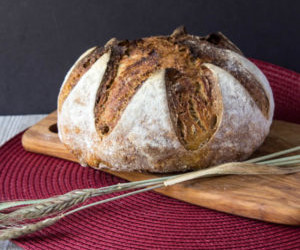

While both types of bread have a low glycemic index, whole wheat outperforms sourdough in fibre and resistant starch levels. But if you ever need to choose one, which do you think is the best? Sourdough vs whole wheat – Which is best?īoth bread types come in their own individual benefits and advantages. With sourdough bread, despite having fewer minerals, we actually benefit more as our bodies can absorb them better. I find it amazing that even though whole wheat bread contains more minerals, they are not well absorbed by our bodies. Importantly sourdough bread is much better at absorbing minerals. Why sourdough is better for you than whole wheat bread This is due to the higher fibre and bran content present in whole wheat bread. Whole wheat bread has fewer carbohydrates and sugars (thus fewer calories) than sourdough bread.

It contains fewer calories, carbohydrates, and sugars.The data above shows that it is far higher than sourdough bread. Wheat bread contains all the bran that makes it higher in resistant starch. Sourdough bread has a little fibre so wheat bread is the clear winner when it comes to fibre content. It has a higher fibre content which means a better option for us to increase our intake of fibre.In many ways whole wheat bread is better than sourdough: You can also use this as a guide on which bread is more suitable for your health needs: Why whole wheat bread is better for you than sourdough Below is the table I made to make it easy for us to see its difference:īased on the data above, here are some of my conclusions. Nutritional comparison between sourdough and wholemeal breadĪfter looking at the benefits of each bread type, let’s see how they compare to each other. When we consume resistant starch, our bodies produce short-chain fatty acids which play an important role in our health. Resistant starch is not commonly found, but whole wheat bread can have up to 14% of it. Vitamin B9 (Folate) makes healthy new cells in our body.Vitamin B3 (Niacin) plays a role in converting the food we eat into energy that keeps our nervous system healthy.It also maintains our body’s energy supply. Vitamin B2 (Riboflavin) helps break down proteins, fats and carbohydrates.Vitamin B1 (Thiamin) enables our body to use carbohydrates as energy.And of course, having a healthy gut means a healthy body! The presence of probiotics also makes sourdough bread easier for the body to digest. This is a type of fibre that feeds the good bacteria in our gut. Sourdough bread contains probiotics which are non-digestible fibres. But sadly, this is far from the amount that whole wheat bread can provide. Sourdough’s fermentation process increases the resistant starch content of bread by about 6%. It can help us with many health factors such as: Resistant starch is a fibre that has been recently discovered to be beneficial to our health. This is due to the presence of lactic acid in sourdough. There is also a high level of antioxidants that straight-dough loaves of bread do not have. Minerals like copper, iron, magnesium, and zinc are absorbed easily when eating sourdough. The extended fermentation process of sourdough allows us to absorb nutrients better.


 0 kommentar(er)
0 kommentar(er)
